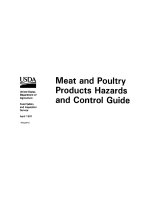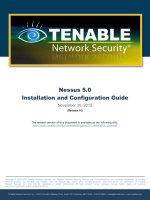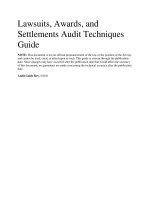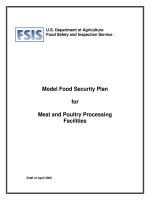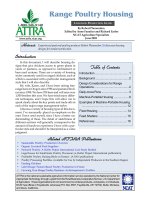Meat and Poultry Hazards and Controls Guide pot
Bạn đang xem bản rút gọn của tài liệu. Xem và tải ngay bản đầy đủ của tài liệu tại đây (729.44 KB, 35 trang )
Meat and Poultry Hazards and Controls Guide
Food Safety and Inspection Service
United States Department of Agriculture
September 2005
1
Table of Contents
Introduction 1
Alphabetical Listing of Process Steps 3
Quick Reference Table of Process Steps by Category 4
Suggested General Verification Questions for Most Process Steps 5
Process Steps, Common Hazards, and Frequently Used Controls 6
Definitions 31
References 34
2
Introduction
FSIS developed this Guide to help FSIS personnel to evaluate all aspects of an
establishment’s system for producing processed meat and poultry products. The Guide
identifies all process steps that may be employed in each process category, lists common
food safety hazards for each process step, and cites some of the controls frequently used by
processors to address these hazards. This Guide provides the FSIS personnel with the
information that he/she needs to determine whether the establishment considered for each
process step all the possible hazards therein as part of its hazard analysis and to verify that
the analysis and the resultant plan are adequate and appropriately take into account the
relevant food safety information. With this Guide, FSIS personnel should be able to verify
more effectively whether an establishment’s food safety system has appropriately accounted
for the hazards that are reasonably likely to occur in its operations.
This Guide should be used by FSIS personnel in performing the verification activities
set out in FSIS Directive 5000.1 with the following guiding principles in mind:
a. This Guide is not intended to suggest where Critical Control Points should
be placed.
b. The statement “no common hazard” is based on the available information
and may change as a result of research or outbreak and recall investigations.
Unforeseen hazards and the results of the reassessments may also identify a
possible hazard in a processing step where none was previously identified.
c. The common hazards listed may not be the only possible hazards for a
particular step.
d. Entries in the “Frequently used controls” column should not be taken as the
only valid controls that establishments may have in place for a particular
hazard. The establishment must have supporting documentation for any
controls they have in place for identified hazards, whether they are the ones
listed in this document or not. Other validated controls for a particular hazard
may be used in an establishment’s food safety system.
e. A set of suggested general and process-specific verification questions is
included in this Guide. These questions will provide the FSIS personnel with
an analytical thought process that may lead the FSIS personnel to ask
additional questions in evaluating the process steps. FSIS personnel should
use the general and process-specific questions in evaluating each process step.
It is important for FSIS personnel to realize that these questions are not meant
to be all inclusive but as a Guide to the types of questions that should be
answered when verifying regulatory compliance.
This Guide should also be valuable to establishment personnel, particularly those in
small and very small plants, in developing the hazard analyses and supporting
documentation. The common hazards and frequently used controls in this Guide are neither
a guaranteed path to safe food, nor are they the only hazards and applicable hazard controls
available to an establishment operator.
3
Each plant must design its own food safety system to meet its needs.
The Guide consists of the following major sections:
• alphabetical listing of process steps that may be used in the production of
processed meat and poultry products and the page numbers where they can be
found;
• quick reference table of process steps by process category, which provides a
quick reference to the most common process steps in the production of
products under the processing categories listed in 9 CFR 417.2;
• an individual listing of 27 processing steps with some currently identified
common hazards and frequently used controls for each process step; and
• definitions of terms used in the guide and a list of references for easy access to
current information on regulations and other guidance material.
4
Click on the links below to be directed to each process step.
Breaded and pre-browned
Brine chilling
Can cooling
Cooking/smoking
Drying
Fermentation
Filling
Formulation
Heating/smoking/charring
Injection/tumbling
Irradiation of raw products
Mixing/grinding/boning/fabrication
Packaging
Patty formation
Preblending
Product handling at shipping time
Receiving and storage of packaging materials and non-meat ingredients
Receiving meat raw materials
Receiving returned product
Retorting
Rework
RTE post-lethality treatment RTE product handling after cooking
Peeling
Slicing
Dicing
Chopping
Mincing
Surface rub
Repackaging
Sealing/closing/capping
Storage after chilling
Storage prior to shipping
Storage prior to use
Stuffing
Thawing frozen meat
5
Quick Reference Table of Process Steps by Category
Process Steps
Page
No.
Process Categories
Raw
Not
Ground
Raw
Ground
Fully
Cooked,
Not
Shelf
Stable
Heat
Treated
Not
Fully
Cooked
Heat
Treated
Shelf
Stable
Not
Heat
Treated
Shelf
Stable
Secondary
Inhibitors
Thermally
Processed,
Commercially
Stable
Receiving meat raw
materials; Storage prior
p. 6
• • • • • • • •
to use
Receiving and storage of
packaging materials and
non-meat ingredients
p. 7
• • • • • • • •
Thawing frozen meat p. 8
• • • • • • • •
Formulation p. 9
• • • • • • • •
Mixing/grinding/boning/
fabrication
p. 10
• • • • • • •
Preblending p. 10
• • • • • • •
Patty formation p. 10
• • • • • •
Stuffing p. 10
• • • • • • • •
Injection/tumbling p. 10
• • • • • • •
Rework p. 11
• • • • • • • •
Fermentation p. 12
• • • • •
Cooking/smoking p. 13
• •
Heating/smoking/
charring
p. 14
• •
Breaded and pre-
browned
p. 14
• •
Drying p. 15
• • •
Filling p. 16
•
Sealing/closing/capping p. 17
•
Retorting p. 18
•
Can cooling p. 19
•
Brine chilling p. 20
• • •
RTE product handling
after cooking
Peeling Slicing
Dicing Chopping
p. 21
• • • •
Mincing Surface rub
Repackaging
Storage after chilling p. 23
• • • • • •
Packaging p. 24
• • • • • • • •
RTE post-lethality
treatment
p. 25
• • •
Irradiation of raw
products
p. 26
• •
Storage prior to shipping;
p. 28
• • • • • • • •
Product handling at
shipping time
Returned product p. 29
• • • • • • • •
Controlling outgrowth of
L. monocytogenes
p. 30
• • • •
6
Suggested General Verification Questions for Most Process Steps
This set of general questions should be asked when evaluating the production process
in light of the relevant process steps. It is intended to assist inspection personnel in verifying
the adequacy of the establishment’s approach to each processing step. Individual processing
steps in this Guide include additional questions that are specific to each processing step.
• Has the establishment included this process step in the flow chart and hazard
analysis?
• Does the establishment have a prerequisite program that addresses this step?
• Has the establishment identified any hazards associated with this step?
• Is this process step a CCP?
• Is the establishment following all procedures identified in the hazard analysis?
• Does the establishment maintain records associated with this step?
• Do records contain information that indicates a reassessment of the hazard analysis or
HACCP plan is necessary?
• Are records made available to FSIS?
• Is the equipment used clean, sanitary, and well maintained?
7
Process Steps, Common Hazards, and Frequently Used Controls
Process Step Common Hazards Frequently Used Controls
• Receiving meat raw
materials
• Storage prior to use
Biological—Potential presence and
outgrowth of the following common
hazards:
• Raw beef and veal products—
Salmonella and E. coli O157:H7
• Raw chicken, turkey and other
poultry—Salmonella and
Campylobacter jejuni/coli
• Raw pork and other products (e.g.,
sheep, equine— Salmonella)
• Ensure product has been prepared
and handled by the source
establishment in a manner that
minimizes the possibility of
pathogen contamination (e.g., letters
or certificates of guarantee, product
temperature tracking, microbial
testing).
Chemical—No common hazard
• Ensure product has been properly
handled prior to acceptance, maintain
package integrity.
Physical—No common hazard
Suggested verification questions:
1. Are products received held under refrigeration to preclude the growth of pathogens?
2. Are products protected from environmental contamination such as dust, moisture, or
other physical contaminants?
8
••
Process Step
Common Hazards
Frequently Used Controls
• Receiving and storage of
packaging materials and
non-meat ingredients
Physical—No common hazard
with written guarantee from
suppliers and enclosed during
transportation
Biological—Contamination with
biological material
Procure letters of guarantee that
materials are free of hazards when
received and store in proper
conditions to prevent a breach in
safety. Dry goods storage should be
protected from pests and
environmental contamination.
Suggested verification questions:
1. Are materials guaranteed by the manufacturer?
2. Are materials protected from environmental contamination (e.g., are containers kept
closed and properly stored in acceptable storage areas)?
9
Process Step Common Hazards Frequently Used Controls
•Thawing frozen raw
meat
Biological—Cross-contamination and
outgrowth of the following common
hazards: •Raw beef and veal
products— Salmonella and E. coli
O157:H7 •Raw chicken, turkey and
other poultry—Salmonella and
Campylobacter jejuni/coli •Raw pork
and other products— Salmonella
•Maintain product at an acceptable
temperature. •When thawing meat, surface
temperature is a concern and should be
monitored. In many cases surface temperature
may rise above common holding temperatures
for a short time period. The duration that the
surface temperature is within the growth range
should be kept to a minimum.
Chemical—No common hazard
•Maintain package integrity.
Physical—No common hazard
Suggested verification questions:
1. Is the process performed at temperatures that preclude pathogen growth?
2. Is the process performed under clean, sanitary conditions?
3. Is package integrity and/or product identity maintained throughout the process?
10
Process Step Common Hazards Frequently Used Controls
•Formulation Note:
Formulation to include an
antimicrobial agent against
L. monocytogenes to meet
the
Listeria Rule requirements
for Alternatives 1 and 2 is
discussed in a separate
process step.
Biological—Outgrowth of certain
pathogens in the final ready-to-eat
(RTE) product. •Examples include
nitrate/nitrite for Clostridium
botulinum
•Checks to ensure the proper ingredient
additions should be in place. Time and
temperature combinations should not be
abused with reliance on nitrates or
nitrites.
•Proper formulation ensures
effectiveness of antimicrobial additives
in preventing outgrowth of certain
pathogens in the final RTE product.
Chemical—Addition of improper
•When using nitrate or nitrite, a check
levels of nitrite or nitrate or other
system should be in place to ensure the
restricted ingredients. •Other restricted
correct amounts are used. •The USDA
ingredients include, but are not limited
limit for nitrite is 156 ppm in
to, o antioxidants o antimicrobial
comminuted product; 200 ppm in
agents o cure accelerators o
pumped, tumbled, or immersed product
flavoring agents (protectors and
(other than bacon); and 120 ppm in
developers) o tenderizing agents
pumped bacon. •A 6.25% mixture of
sodium nitrite in salt is preferred for
consumer safety.
Physical—No common hazard •Maintain protection from environment.
Suggested verification questions:
1. Are ingredients being used in the actual formulation in amounts that agree with the
establishment’s documented formulation for the particular product?
2. Are amounts of restricted ingredients used in compliance with regulations for
restricted ingredients?
3. Is rework included in product formulations? If yes, see rework process step.
4. Are all ingredients being used in actual formulation included in product formula
and listed in descending order of predominance that agrees with the ingredient
statement on the approved label for the product?
11
Process Step Common Hazards Frequently Used Controls
•Mixing/grinding/boning
/fabrication
Biological—Potential outgrowth of raw
product pathogens, including
•Maintain product at an acceptable
temperature.
•Preblending •Patty
formation •Stuffing
•Injection/tumbling
•Raw beef and veal products—
Salmonella and E. coli O157:H7; •Raw
chicken, turkey, and other poultry—
Salmonella and Campylobacter
jejuni/coli; and
•Raw pork and other products—
Salmonella
Biological—Contamination from
unclean equipment
Note: No common hazard with adequate
Sanitation Standard Operating
Procedure (SSOP)
•Proper cleaning procedures, visual
inspection, and effective SSOPs.
•Pathogen contamination in meat is not
destroyed by cold storage and must be
prevented or eliminated.
Chemical—No common hazard •See formulation hazard.
Physical—Metal and other physical
contamination from grinder, mixer, or
chub clips
•Implement an appropriate screening
procedure for monitoring equipment
and/or product.
•FSIS Directive 7310.5 states that a
processor should use the most sensitive
detection technique available.
Suggested verification questions:
1. Is ingoing product wholesome and free of physical contaminants?
2. Is rework included in the process? If yes, see rework process step.
3. Are ingredients included in product formulas in amounts that agree with the
establishment’s documented formula for the particular product?
4. Are amounts of restricted ingredients used in compliance with regulations for
restricted ingredients?
12
Process Step Common Hazards Frequently Used Controls
•Rework Biological—For raw product that is reworked,
outgrowth of pathogens in raw product: •Raw
beef and veal products—Salmonella and E. coli
O157:H7 •Raw chicken, turkey, and other
poultry— Salmonella and Campylobacter
jejuni/coli •Raw pork and other products—
Salmonella Biological—For RTE product that is
reworked, cross-contamination from raw
•Maintain product at an acceptable
temperature.
products and outgrowth of Listeria
monocytogenes
Chemical—No common hazard
Physical—Metal and other physical
contamination from grinder, mixer, chub clips,
•Appropriate screening procedure for
monitoring equipment and/or product.
etc.
Suggested verification questions:
1. Have products to be used for rework been properly stored to preclude pathogen
growth and contamination?
2. Are there any hazards associated with rework that are different from hazards
associated with the product it is being added to?
3. Does the establishment have any additional controls for rework product (e.g., length
of time in storage, results of examination when received)?
4. Does the establishment conduct microbiological testing of rework product?
5. Are all ingredients of the rework declared on the label of the finished product, and
are they listed in the correct order of predominance?
13
Process Step Common Hazards Frequently Used Controls
•Fermentation Biological—Raw product pathogens
including •Raw beef and veal products—
Salmonella and E. coli O157:H7; •Raw
chicken, turkey, and other poultry—
Salmonella and Campylobacter
jejuni/coli; and •Raw pork and other
products— Salmonella. Biological—
Semi-dry/fermented product pathogens
including •Outgrowth of Staphylococcus
aureus and Clostridium spp. that might
•Reduce pH of product to an acceptable level
in an acceptable time period to prevent
possible outgrowth and toxin production from
S. aureus. •Meat pH should decline to 5.3
within an acceptable time temperature
combination (temperature in degrees F (°F),
time in hours). To calculate degree hours, the
following equation can be used.
•[Fermentation Temperature (°F) – 60] x time
(hours) = degree hours and the process is
occur from inadequate fermentation.
acceptable if o Fewer than 1,200 degree
Note: Some semi-dry/ fermented products
undergo marginal processing treatments.
hours when the lowest fermentation
temperature is less than 90°F (32°C). o
Therefore, the microbiological quality of
Fewer than 1,000 degree hours when the
ingredients is crucial to the final
highest fermentation temperature is between
product’s safety.
90°F (32°C) and 100°F (38°C). o Fewer than
900 degree hours when the highest
fermentation temperature is greater than 100°F
(38°C).
Chemical—No common hazard
•Maintain protection from environment.
Physical—No common hazard
Suggested verification questions:
1. Does the establishment conduct microbiological testing of ingredients?
2. Does the establishment conduct microbiological testing of finished products?
3. Are starter cultures used at the manufacturer’s recommended levels and not in
excess of the amount permitted by regulation?
4. Are times, temperatures, pH, water activity, and drying conditions monitored
throughout the process?
5. Does the process result in a shelf-stable finished product?
6. If the finished product is not shelf stable, is the product accurately labeled?
14
Process Step Common Hazards Frequently Used Controls
•Cooking/smoking (fully
cooked)
Biological—Raw product pathogens
and parasites including •Raw beef and
veal products— Salmonella and E.
coli O157:H7; •Raw chicken, turkey,
and other poultry—Salmonella and
Campylobacter jejuni/coli; and •Raw
pork and other products— Salmonella
and Trichinella spiralis.
•The final internal temperature and dwell
time of the product are recommended to
reach a Salmonella lethality level of 6.5
log units for beef and 7.0 log units for
poultry.
Chemical—No common hazard
•Maintain protection from environment.
Physical—No common hazard
Suggested verification questions:
1. Does the process achieve the required lethality treatment?
2. Does the establishment conduct microbiological testing of products?
3. Are time/temperature combinations monitored throughout the process?
4. Does the establishment have validated procedures for reprocessing in the event of a
process deviation?
15
Process Step Common Hazards Frequently Used Controls
•Heating/smoking/charring
•Breaded and pre-browned
(i.e., not fully cooked [not
RTE]), (e.g., bacon)
Biological—Outgrowth of raw
product and other pathogens that
might occur because of improper time
and temperature: •Raw beef and veal
products— Salmonella and E. coli
O157:H7
•When a product is not a fully cooked
product, the final internal temperature is
not required to reach a specific
temperature; however, the time that the
product is in the danger zone of
microbial growth should be minimized.
•Raw chicken, turkey, and other
poultry—Salmonella and
Campylobacter jejuni/coli
•Raw pork and other products—
Salmonella
•All raw products—outgrowth of
Clostridium botulinum and
Clostridium perfringens
Chemical—No common hazard
•Maintain protection from environment.
Physical—No common hazard
Suggested verification questions:
1. Is the heating/smoking one part of a multistep “treatment?” If so, the link to the rest
of the treatment element is also critical.
2. Does the heating/smoking result in an RTE product? If the finished product is
NRTE, the product must be accurately labeled to inform the consumer of that fact.
3. Does the establishment conduct microbiological testing of products?
4. Are time/temperature combinations monitored throughout the process?
5. Does the finished product exhibit a “cooked” appearance without being fully
cooked?
16
Process Step Common Hazards Frequently Used Controls
•Drying Biological—Raw product pathogens including
•Raw beef and veal products— Salmonella and
E. coli O157:H7; •Raw chicken, turkey, and
other poultry—Salmonella and Campylobacter
jejuni/coli; and
•As the water activity of a product
decreases, most bacteria cannot grow.
Ensure that the water activity, pH, and
temperature of a product prevent
pathogen outgrowth.
•Raw pork and other products— Salmonella.
•All raw products—Outgrowth of
Staphylococcus aureus, Clostridium botulinum,
and Clostridium perfringens
Chemical—No common hazard
•Maintain protection from environment.
Physical—No common hazard
Suggested verification questions:
1. Does the establishment conduct microbiological testing of products?
2. Are temperature, relative humidity, and air flow controlled throughout the process
so that drying proceeds properly?
3. Are times, temperatures, pH, water activity, and drying conditions monitored
throughout the process?
4. How is the establishment ensuring that process deviations do not result in
adulterated product?
17
Process Step Common Hazards Frequently Used Controls
•Filling (can or retortable
pouch)
Biological—Clostridium botulinum
spores
•Overfilling can compromise the commercial
sterility process that ensures destruction of C.
botulinum spores. Consult a thermal process
authority to ensure proper filling and retorting
procedures.
Chemical—No common hazard
•Maintain protection from environment.
Physical—No common hazard
Suggested verification questions:
1. Are empty containers, closures, and flexible pouch stock evaluated by the
establishment to ensure that they are clean and free of structural defects and
damage?
2. Are rigid containers used?
3. Are rigid containers cleaned just before filling per 9 CFR 318.301 (a) (3) and
381.301 (a) (3)?
18
Process Step Common Hazards Frequently Used Controls
Sealing/closing/capping (can Maintain protection from environment.
or retortable pouch) Biological—No common hazard Ensure proper sealing by appropriate testing.
Chemical—No common hazard
Physical—No common hazard
Suggested verification questions:
1. Did a closure technician examine the double seams formed by each closing machine
head?
2. Was the entire container examined for product leakage or obvious defects?
3. Was a visual inspection performed on at least one container from each closing
machine head, and were the observations along with any corrective actions
recorded?
4. Were visual examinations conducted with sufficient frequency to ensure proper
closure?
5. Were visual examinations conducted at least every 30 minutes of continuous
closing machine operation?
6. Are closure examinations and physical tests carried out in accordance with 9 CFR
318.301 and 381.301?
19
Process Step Common Hazards Frequently Used Controls
•Retorting
Biological—Clostridium botulinum
spores
•Consult a thermal process authority for
proper retorting and commercial
sterility procedures.
Chemical—No common hazard
•Maintain can/package integrity.
Physical—No common hazard
Suggested verification questions:
1. Does the establishment have a process schedule?
2. Has there been a change in product formula and, if so, has the schedule been
updated?
3. Are appropriate letters/written communications from the processing authority on
file?
4. Are the critical factors specified in the process schedule measured, controlled, and
recorded by the establishment?
5. Is each retort equipped with at least one temperature device measuring the actual
temperature within the retort?
6. Is each thermal processing system equipped with at least one temperature/time
recording device to provide a permanent record of temperature within the system?
7. Is each retort equipped with an automatic steam controller?
8. Do air and water valves comply with 9 CFR 318.305 and 381.305?
9. Are the requirements of 9 CFR 318.305 (5) (b) (c) (d) (e) and (f) and 381.305 (5)
(b) (c) (d) (e) and (f) met?
20
Process Step Common Hazards Frequently Used Controls
•Can cooling
Biological—Microbial contamination
of product
•Bacterial contamination of cooling water
should be minimized to reduce the risk of
contamination into cans while the seams are
stressed.
Chemical—No common hazard
•Maintain can/package integrity.
Physical—No common hazard
Suggested verification questions:
1. Is potable water used for cooling, except as provided for in 9CFR 318.305 (h) and
381.305(h)?
2. Is cooling canal water chlorinated or treated with a chemical appropriate for this
use?
3. Are cooling waters that are recycled or reused handled in systems so designed for
such use?
4. Is system equipment such as pipelines, cooling towers, and holding tanks
constructed and installed so they may be easily cleaned and inspected?
21
Process Step Common Hazards Frequently Used Controls
•Chilling, including brine
chilling
Biological—Clostridium perfringens
and Clostridium botulinum outgrowth
due to time and/or temperature abuse.
•Cool product within proper window of time
to prevent growth of Clostridium
perfringens and Clostridium botulinum
spores that germinated after cooking.
Biological—Contamination from
chilling solution
•Sanitation of chilling solution. •NaCl
concentration and temperature of
the brine solution should be kept at levels
that destroy or prevent growth of
pathogens.
Chemical—No common hazard
•Maintain protection from environment.
Physical—No common hazard
Suggested verification questions:
1. Is the solution maintained at the proper concentration and temperature?
2. If the solution is reused, is it properly filtered and maintained free of contaminants?
3. Are FSIS personnel notified when a deviation occurs?
22
Process Step Common Hazards Frequently Used Controls
•RTE product handling
after cooking, including o
Peeling o Slicing o
Dicing o Chopping o
Mincing o Surface rub o
Repackaging
Biological—Contamination and
outgrowth of Listeria monocytogenes
from food contact surfaces and other
environmental sources Biological—
Contamination by pathogens from
raw product areas, including
Salmonella, Campylobacter, and E.
coli O157:H7 Biological—
Outgrowth of Staphylococcus aureus,
Clostridium perfringens, and
Clostridium botulinum
•All post-cook handling should be
minimized and the utmost care given to
everything that may come into contact with
the cooked product. •Prevent cross-
contamination from uncooked product.
Sequester raw and cooked product areas and
regulate the flow of personnel, carts, and
equipment between those areas. •Post-
process sanitation is critically important.
Sampling and testing food contact surfaces
and other environmental
surfaces for Listeria spp. or Listeria-like
organisms provide information on potential
sources for Listeria monocytogenes
contamination. On-site construction can free
harbored L.
monocytogenes within the plant
environment, requiring extra diligence put
toward testing and sanitation. See FSIS
Listeria Rule, Directive and
Compliance Guidelines for additional
information on L. monocytogenes control in
RTE establishments.
•Pathogen contamination in meat is not
destroyed by cold storage and must be
prevented or eliminated.
•Ensure the cleanliness and
microbiological quality of spices added to
cooked product as a surface rub.
•Unless other methods such as pH or water
activity level are used to prevent growth,
proper temperature and time limits should
be maintained.
Chemical—No common hazard
•Maintain protection from environment
Physical—No common hazard
Suggested verification questions:
1. Has the establishment selected one of the three alternatives per 9 CFR 430.4 (b)?
2. Is the post-lethality treatment included in the establishment’s HACCP plan?
3. Is the antimicrobial agent or process included in the establishment’s HACCP plan,
SSOP, or prerequisite program?
4. Has the establishment validated the effectiveness of the treatment?
5. Is product separation maintained to prevent contamination from uncooked product?
6. Does the establishment perform microbiological testing of ingredients such as
spices and coatings that are added to the product after cooking?
23
Process Step Common Hazards Frequently Used Controls
•Storage after chilling Biological—For raw products in
storage, outgrowth of raw product
•Unless product is shelf stable, other methods
must be used to prevent growth (e.g., low pH,
pathogens including •Raw beef and
veal products— Salmonella and E. coli
freezing, low water activity, refrigeration
temperature and time limits).
O157:H7; •Raw chicken, turkey, and
other poultry—Salmonella and
Campylobacter jejuni/coli; and •Raw
pork and other products— Salmonella.
Biological—For RTE products in
storage, outgrowth of Staphylococcus
aureus, Clostridium botulinum, and
Clostridium perfringens and potential
for outgrowth of Listeria
monocytogenes.
Chemical—No common hazard
•Maintain protection from environment.
Physical—No common hazard
Suggested verification questions:
1. Are products properly refrigerated after chilling?
2. Does the establishment use methods other than refrigeration to prevent pathogen
growth? If so, are the methods validated as effective and monitored?
24
Process Step Common Hazards Frequently Used Controls
•Packaging Biological—No common hazard •Packaging material should be adequate to prevent
bacterial, chemical, or physical contamination. •All
post-cook handling should be minimized and the
utmost care given to everything that may come into
contact with the cooked product.
Chemical—No common hazard
•Maintain package integrity.
Physical—No common hazard
Suggested verification questions:
1. Are packaging materials covered by letters of guaranty or statements of assurance
from the suppliers?
2. Are packaging materials properly stored and protected from environmental
contamination?
25
